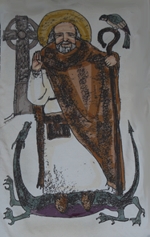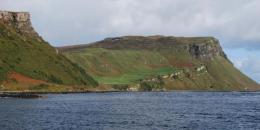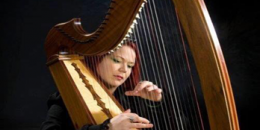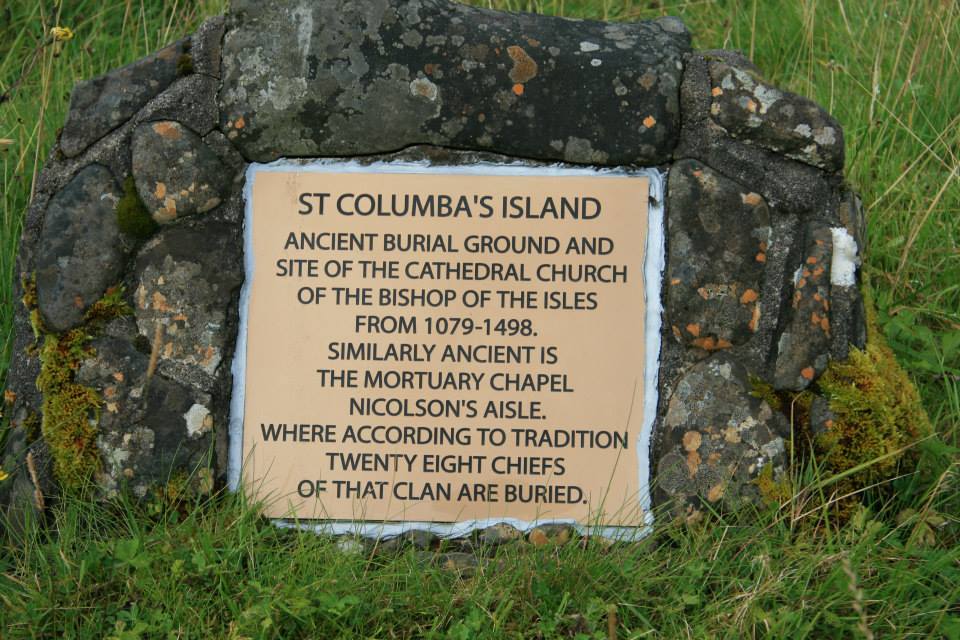
The inscription on this monument reads:
Saint Columba's Island - Ancient Burial Ground and Site of the Cathedral Church of the Bishops of the Isles from 1079 to 1498. Similarly Ancient is the Mortuary Chapel Nicolson's Aisle, Where According to Tradition, Twenty Eight Chiefs of that Clan are Buried.
The ancient site of Eilean Chaluim Chille (St. Columba's Isle) is located in Skeabost, at the head of Loch Snizort, approximately 8 kilometers from Portree. The site is not only a sacred burial ground, but was also a major ecclesiastical center on the Isle of Skye, and the seat of the Bishop of the Isles from the 10th up to the 16th century. According to tradition twenty-eight chiefs of the MacNicols or Nicolsons lie buried in holy ground on St. Columba's Isle. This seems to indicate the important role that the MacNicol clan played in the life of the Church, and the trust the Church placed in the chiefs of Clan MacNicol.
Saint Columba as depicted at his visit to Castle Urquhart near Loch Ness |
According to tradition, a cathedral was founded near a site where Columba had preached from a rock, which later became known as St. Columba's rock. St. Columba was the most significant missionary during this period and the story of his life can be found at Wikipedia.
The site may originally have been a pagan Pictish centre, but by the time of Columba's arrival may have converted to a Pictish Christian establishment. Over the early centuries of the 2nd Millennium the Snizort Cathedral gained importance as the Kilmuir monastery declined and by the 14th Century was referred to as the Metropolitan Church of the Isles, being the principal seat for the Bishops of the Isles known as the Diocese of Sodor, one of thirteen medieval diocese of Scotland, until the seat was transferred to Iona Abbey.
It is said that Columba, a missionary from Ireland, made two trips to Skye and established five different monastic communities modeled on the center he had established in Iona, of which St. Columba's Isle was considered the most significant. The Island once housed a cathedral and abbey. Archeology and records confirm the great church had an 80 foot transept, built in a style of the Iona Abbey. For over 400 years, from 1079 until 1498 this cathedral church was considered one of the most important anywhere in Scotland.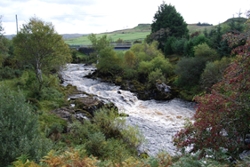
The Skeabost Diocese, was founded under the authority of the Archbishop of Nidaros (Trondheim) in Norway. In 1097, Bishop Wymond or Wimund was consecrated in York and installed as Bishop of Skye and all the Isles. According to William of Newburgh Bishop Wimund became a seafaring warlord adventurer in the years after 1147.
The new Skeabost diocese extended from the Butt of Lewis in the north to the Isle of Man in the south and included Iona Abbey. The seat of the Bishop remained here until 1491 when the Lordship of the Isles under the MacDonalds ceded to the crown. By 1501, the seat of the diocese had moved to Iona, and church center at Skeabost declined and was eventually forgotten. After the Reformation, the great cathedral was destroyed and much of the stone used to build a retaining wall in Portree.

The MacNeacail mortuary chapel, burial site of 28 MacNeacail Chiefs
This video contains footage of the St Columba's Isle
Video by Jakub Bors Photography
The following is an extract from History of the Highland Clan MacNeacail, by David Seller.
 Today, St. Columba's is sacred burial ground containing not only residents of Skye, but also the burial place of the Bishops who served the Cathedral up until the Reformation in the late 1400's. Within a mortuary chapel on the island is the burial place of 28 MacNeacail chiefs. This small chapel is known as Aite Adhlaic Mhic Neacail, rendered loosely in English as MacNicol or Nicolson's Aisle. Within the chapel lies a 16th century effigy of a warrior wearing a high conical helmet and holding a sword, point down, in front of his legs. It would appear to represent a contemporary MacNeacail chief, perhaps the one who entertained King James V in 1540. Until 1992, the chapel was in ruined state, the effigy displaced in a jumble of fallen masonry. During the clearing up which followed the stabilization of the walls in the following year, the ground surface was found to be strewn with broken wine glasses and bottle fragments indicating that the chiefs interred there had been accorded a liberal and liquid farewell.
Today, St. Columba's is sacred burial ground containing not only residents of Skye, but also the burial place of the Bishops who served the Cathedral up until the Reformation in the late 1400's. Within a mortuary chapel on the island is the burial place of 28 MacNeacail chiefs. This small chapel is known as Aite Adhlaic Mhic Neacail, rendered loosely in English as MacNicol or Nicolson's Aisle. Within the chapel lies a 16th century effigy of a warrior wearing a high conical helmet and holding a sword, point down, in front of his legs. It would appear to represent a contemporary MacNeacail chief, perhaps the one who entertained King James V in 1540. Until 1992, the chapel was in ruined state, the effigy displaced in a jumble of fallen masonry. During the clearing up which followed the stabilization of the walls in the following year, the ground surface was found to be strewn with broken wine glasses and bottle fragments indicating that the chiefs interred there had been accorded a liberal and liquid farewell.
If the tradition of burial at Snizort is accurate, the connection between the Clann MhicNeacail or Nicolson and Skye must be as old as the name itself.

Clan archeologist James Nickelson has written an indepth article titled "A Brief History and Archaeology of St. Columba’s Isle at Skeabost" which details the history of the isle.
CLAN FEUDS NEAR ST. COLUMBA'S ISLE
According to Derek Cooper in his book Skye, Skeeabost was not always a peaceful place of church going people. In the late 16th century the MacDonalds and MacLeods fought for the possession of Trotternish and other land on Skye. Cooper states, "In 1539 a bloody battle took place between the Macleods and MacDonalds and several heads cut off in the fray were later seen floating down the River Snizort."
RECENT HISTORY ON ST. COLUMBA'S ISLE
- 2004: Because of the significance of St. Columba's Isle with the Chiefs of Clan MacNeacail, our current Chief, John MacNeacail scattered the ashes of his father and our beloved Chief, Iain who died in Oct 2003, in the area of Nicolson's Aisle to rest with his ancestors.
- 13 Oct 2018: During a tour of St Columba's Isle as part of the 2018 Clan MacNeaceail International Gathering, Jenni Nicolson, the wife of the Chief of the Clan pushed away some turf from a small piece of granite adjacent to Nicolson's Aisle. As more turf was removed, she and Scorrybreac discovered another significant grave marker of a soldier with a sword. It will take some time to expose the details of the stone, but this is indeed a significant find as it is along the wall of the chapel.


